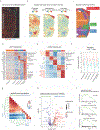Integration of whole transcriptome spatial profiling with protein markers
- PMID: 36593397
- PMCID: PMC10272089
- DOI: 10.1038/s41587-022-01536-3
Integration of whole transcriptome spatial profiling with protein markers
Abstract
Spatial transcriptomics and proteomics provide complementary information that independently transformed our understanding of complex biological processes. However, experimental integration of these modalities is limited. To overcome this, we developed Spatial PrOtein and Transcriptome Sequencing (SPOTS) for high-throughput simultaneous spatial transcriptomics and protein profiling. Compared with unimodal measurements, SPOTS substantially improves signal resolution and cell clustering and enhances the discovery power in differential gene expression analysis across tissue regions.
© 2023. The Author(s), under exclusive licence to Springer Nature America, Inc.
Figures


References
Publication types
MeSH terms
Substances
Grants and funding
LinkOut - more resources
Full Text Sources
Molecular Biology Databases

